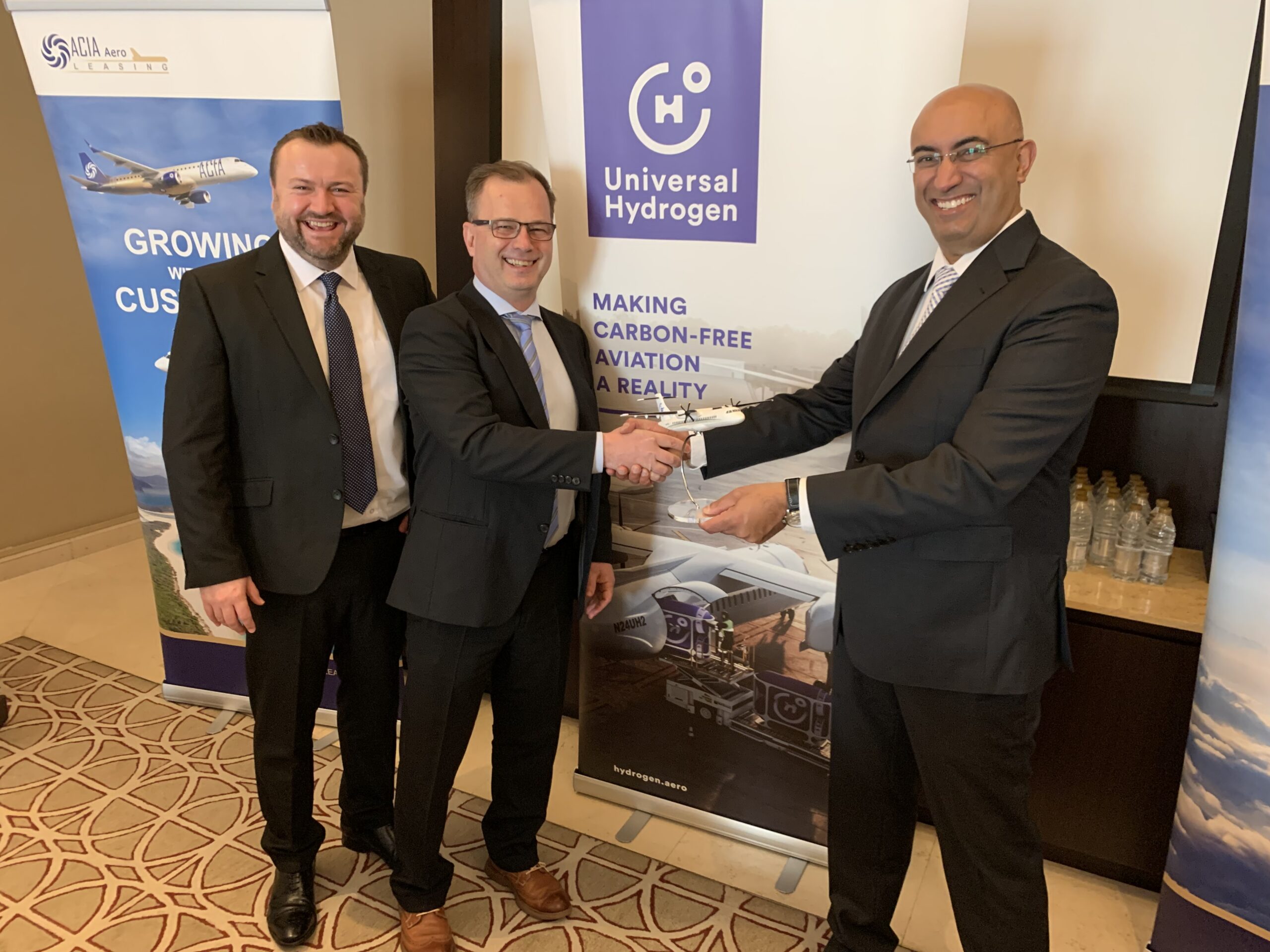
IMG 0022 scaled
Lessor ACIA Aero Leasing and Universal Hydrogen have signed a Letter of Intent to convert up to thirty ATR 72-600s for use of Universal’s hydrogen kit. The two companies announced the agreement on November 13, ‘Day zero’ on the 2021 Dubai Airshow. The agreement has the option to include other aircraft types as well. ACIA and Universal Hydrogen announce LoI for 30 ATRs.
ACIA currently has a managed fleet of six ATR 42 and fifteen 72. It plans to convert only the bigger model and have them all flying on liquid hydrogen by the end of the decade. “Hopefully, this is the standard of things to follow”, said ACIA CEO Mick Mooney. “As we have seen at this week’s COP26 climate summit in Glasgow, everybody is worried about climate change. That’s why we think we have to take this step.” Mooney says the customers are pushing the industry for making technological changes.
Start-up Universal Hydrogen was launched in 2020. It is developing a conversion kit for the De Havilland Canada Dash 8 and ATR to fly on hydrogen. The hydrogen is inside modular capsules that are interchangeable at the back of the aircraft, occupying the space of two or three-seat rows and therefore reducing capacity by ten to fifteen passengers compared to the conventional layout.
The hydrogen is converted into electricity by using fuel cells. The electricity powers two electric MagniX motors with a 2 megaWatt output that replaces the Pratt & Whitney turboprops. There is a high-pressure gaseous capsule that has a 400 nautical mile range and a liquid hydrogen capsule offers 500 nautical miles. The timeline is to certify the retrofit kit and get an STC type certificate by 2025.
While Universal announced agreements with ASL Aviation Services for conversion of an ATR 72 and with Icelandair and Spanish airline Air Nostrum for the Dash 8-300, Chief Commercial Officer Rod Williams says that the ACIA LoI is so far the biggest deal. “This is our fifth LoI. We have a number of LoI’s that are signed but haven’t been announced as they are still confidential. Overall, the engagement has been fantastic. With over 45 airlines with over 600 aircraft, we have different levels of engagement. There is tremendous interest in our product and as well as getting to a true carbon-zero solution.”
The hydrogen capsule and fuel cell product might find its first way on cargo aircraft, both Universal and ACIA think, but as the price of hydrogen and the power train come down, it will become competitive for passenger services as well. “By 2025, we expect the proceeds of the economics of the per-time kilometer economics of the cargo aircraft to be equivalent to the costs of a Jet-A aircraft”, says Williams.
While hydrogen is still in its infant stages, it has gained huge momentum since Airbus committed itself to it with its ZERO program. Everywhere, initiatives are developing to get the production of (liquid) hydrogen going. Earlier this week, Universal announced an MoU with Fortescue Future Industries (FFI) to offer a hydrogen supply for aviation on a global scale already this decade and certainly next decade. With its capsule technology, Universal isn’t dependent on expensive hydrogen infrastructure at airports themselves.
The idea to join forces was a collective decision, says ACIA’s Senior Vice President Commercial, Sameer Adam. “We have been looking at our commercial strategy for the next few years and how we see the requirements of the market and the demands of not only the traveling public but also the operators. And as we explored the various technologies, we have identified that Universal Hydrogen is a strong player in the market. We see an opportunity with the diverse approach they take to both turboprop platforms (ATR and DHC).”
As announced last week, ACIA has issued a requests for proposals for some thirty aircraft to grow its fleet to around ninety in two to three years. That’s the short-term plan, but medium-term, the lessor wants to be part of the sustainability and net-zero plans for aviation, hence its choice to go for hydrogen with Universal. “By nature of how ACIA operates, we are somewhat disruptive”, says Sameer Adam. “We are not a traditional lessor, we certainly have some aspects related to operations of our sister companies (ACIA Capital and IPR Conversions). When we look at something like a partnership with Universal, this is really looking at how our fleet would grow best in the foreseeable future. But at the same time, it has to be something that makes commercial sense for all partners.”
Adam admits that before ACIA can lease a hydrogen turboprop to a customer, it first has to make a significant investment in converting the aircraft for the new fuel. That could push up lease rates. “The upward impact of a lease rate is more of what it would cost if doing anything. It’s really trying to stay at the forefront if you will and in this case lead the change and lead the ideology around lessors and stakeholders working together. The approach of Universal Hydrogen goes beyond just converting the powertrain. We are talking about logistics, how we work together as a lessor and service provider that is going to make a step-change.”
Here are two videos with Rod Williams of Universal Hydrogen…
… and with ACIA’s Sameer Adam:
Views: 3



